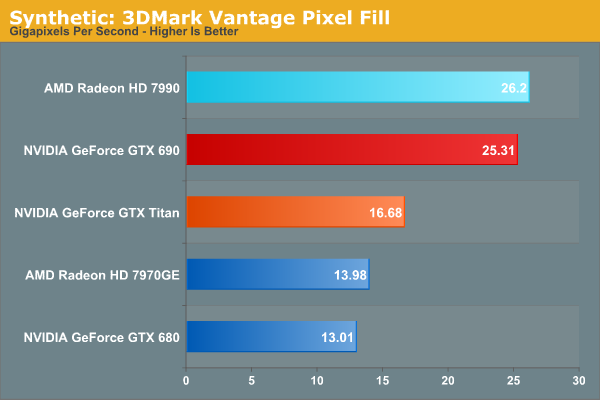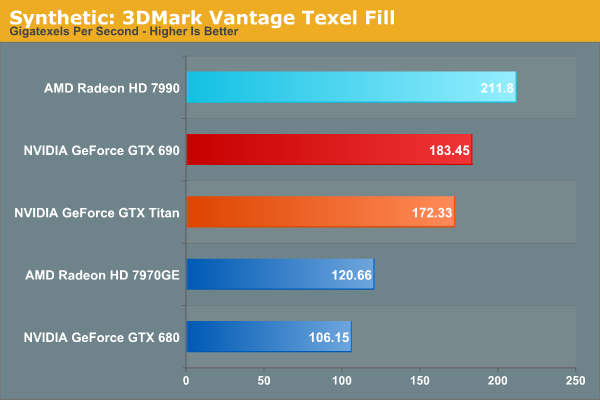AMD Radeon HD 7990 Review: 7990 Gets Official
by Ryan Smith on April 24, 2013 12:01 AM EST- Posted in
- GPUs
- AMD
- Radeon
- Radeon HD 7000
- Tahiti
Synthetics
As always we’ll also take a quick look at synthetic performance, though as a multi-GPU card using a known GPU, there shouldn't be any surprises here. These tests are mostly for comparing cards from within a manufacturer, as opposed to directly comparing AMD and NVIDIA cards. We’ll start with 3DMark Vantage’s Pixel Fill test.

There’s not much to say here. So long as the 7990 isn’t throttling, its ROP/memory performance is almost twice that of the 7970GE, reflecting the fact that the two cards’ clockspeeds are so close.
Moving on, we have our 3DMark Vantage texture fillrate test, which does for texels and texture mapping units what the previous test does for ROPs.

Texture fillrates are the same story as pixel fillrates: the 7990 is an extremely capable card.
Finally we’ll take a quick look at tessellation performance with TessMark.

And again, we're seeing almost perfect scaling from the 7970GE to the 7990 in our synthetic tests.










91 Comments
View All Comments
Ryan Smith - Wednesday, April 24, 2013 - link
One of our goals this year is to get a 4K monitor. But if so it will be a bit more mundane; something cheaper and more accessible, and something that can do 4K off of 1 DP 1.2 connection and present itself as one monitor.mayankleoboy1 - Wednesday, April 24, 2013 - link
How do you use SSAA in Crysis:Warhead ?Ryan Smith - Wednesday, April 24, 2013 - link
You can force it through the drivers on both AMD and NVIDIA cards.Veteranv2 - Wednesday, April 24, 2013 - link
One giant massive pro for the 7990 is compute performance. Nvidia clearly misses the ball there.StealthGhost - Wednesday, April 24, 2013 - link
Massive...for the 5% of people who buy cards like this and don't gameVeteranv2 - Wednesday, April 24, 2013 - link
Not all graphic cards are bought for gaming....And certainly in the future, compute for GPU will be more and more important.
Have you looked at the graphs? AMD has a GIANT leap over Nvidia.
Ktracho - Wednesday, April 24, 2013 - link
I think the compute benchmarking may be flawed. How many people who buy the Titan for compute will use OpenCL? I suspect almost all would be using CUDA. Since CUDA isn't available on AMD cards, I think a better benchmark would be HPL, which is a common benchmark in the HPC world. This would allow each manufacturer to show how much sustained performance a given card is capable of achieving, without being limited by the constraint of having to use OpenCL or DirectCompute, or whatever. Without such benchmark results, all that can be concluded without reservation is that if you must use OpenCL, then you really should limit yourself to AMD (at least for now).BrightCandle - Wednesday, April 24, 2013 - link
Lets be clear, you went live without FCAT results, which are singularly the most important aspect of reviewing this card as every other site has shown. Instead you chose to go with single FPS numbers, again.Pages upon pages of useless numbers, because the card doesn't actually display those frames. Using an older driver would have been better than using a prototype driver users aren't expecting to use for at least another month.
MartinT - Wednesday, April 24, 2013 - link
I agree, the data set in this review is of very limited import, especially for a CF-on-a-stick solution.You probably should have devoted more time to getting frame times into your workflow, and less time benchmarking so many games using less than relevant methodology.
Looking forward to your write up of the frame time data, but this article is a serious waste of time on your part, I'm afraid.
Ryan Smith - Wednesday, April 24, 2013 - link
Obviously we planned to have full FCAT data for this, but fate wasn't so agreeable. In any case FCAT is meant to augment our FPS data, not replace it. So we needed to have the FPS numbers before we could dig into FCAT for the full breakdown.And as a point of clarification, we aren't using the prototype driver for these results. We're using Catalyst 13.5b2, which should see a public release in the very near future. The prototype driver is another driver entirely, which we aren't using for these tests.